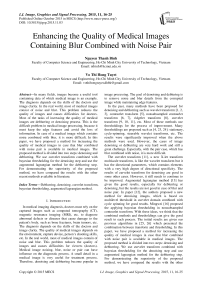Enhancing the Quality of Medical Images Containing Blur Combined with Noise Pair
Автор: Nguyen Thanh Binh, Vo Thi Hong Tuyet
Журнал: International Journal of Image, Graphics and Signal Processing(IJIGSP) @ijigsp
Статья в выпуске: 11 vol.7, 2015 года.
Бесплатный доступ
In many fields, images become a useful tool containing data of which medical image is an example. The diagnosis depends on the skills of the doctors and image clarity. In the real world, most of medical images consist of noise and blur. This problem reduces the quality of images and causes difficulties for doctors. Most of the tasks of increasing the quality of medical images are deblurring or denoising process. This is the difficult problem in medical image processing, because it must keep the edge features and avoid the loss of information. In case of a medical image which contains noise combined with blur, it is more difficult. In this paper, we have proposed a method for increasing the quality of medical images in case that blur combined with noise pair is available in medical images. The proposed method is divided into two steps: denoising and deblurring. We use curvelet transform combined with bayesian thresholding for the denoising step and use the augmented lagrangian method for the deblurring step. For demonstrating the superiority of the proposed method, we have compared the results with the other recent methods available in literature.
Deblurring, denoising, curvelet transform, bayesian thresholding, augmented lagrangian method
Короткий адрес: https://sciup.org/15013923
IDR: 15013923
Текст научной статьи Enhancing the Quality of Medical Images Containing Blur Combined with Noise Pair
Published Online October 2015 in MECS
In medical imaging diagnosis, doctors must rely on the captured images such as computed tomography (CT), magnetic resonance imaging (MRI), etc. to diagnose abnormal defects or diseases that cause damage to the patient's body, such as bone fractures, brain tumors, etc. The diagnosis depends on the skills of the doctors and image clarity. The quality of medical images depends on the environment, capture device, person’s shooting skills, etc. In the real world, most of medical images contain of noise and blur. This problem reduces the quality of images and causes difficulties for viewers (doctors). Medical image noising, blur, noise or pair can have influence on the diagnostic process. A small detail in a medical image is very useful for treatment process. Therefore, denoising and deblurring become popular in image processing. The goal of denoising and debluring is to remove noise and blur details from the corrupted image while maintaining edge features.
In the past, many methods have been proposed for denoising and deblurring such as wavelet transform [1, 2, 3], contourlet transform [5], nonsubsampled contourlet transform [6, 7], ridgelet transform [8], curvelet transform [9, 10, 11], etc. Most of these methods use thresholdings for the process of improvement. Many thresholdings are proposed such as [4, 23, 24]: stationary, cycle-spinning, steerable wavelet transforms, etc. The results were significantly improved when the above methods were used. However, the cases of image denoising or deblurring are very hard work and still a great challenge. Especially, with the pair case, which has blur combined with noise, it is more difficult.
The curvelet transform [11], a new X-let transform multiscale transform, is like the wavelet transform but it has the directional parameters, which contains elements with a very high degree of directional specificity. The results of curvelet transform for denoising are good in some other cases. However, it still needs to continue to be improved. Augmented lagrangian method [13] has given the good results, especially for deblurring or denoising, but the results are not good in case of blur and noise pair. In paper [12], the authors proposed a new method for denoising images, which is based on multilevel threshold in curvelet domain combined with cycle spinning for good results. Mingwei [16] proposed the applying bayesian thresholding in nonsubsampled contourlet transform. With these ideas, we think that the combined methods and thresholdings can give the good result to each process. The initial results are given our previous algorithms in [25, 26] which presented the combination between transform and thresholding. In this paper, we have proposed a method for increasing the quality of medical images in case that blur combined with noise pair is available in medical images. The proposed method is divided into two steps: denoising and deblurring. We use curvelet transform combined with bayesian thresholding for the denoising step and use augmented lagrangian method for the deblurring step. For demonstrating the superiority of the proposed method, we have compared the results with the other recent methods available in literature such as: discrete wavelet transform (DWT) [2], curvelet transform [11] and augmented lagrangian [13]. For performance measure, we have used Peak Signal to Noise Ratio (PSNR) and Mean Square Error (MSE) and it has shown that the results of the present method are better than the other methods. The rest of the paper is organized as follows: in section II, we describe the basic of curvelet transform, principle bayesian thresholding and augmented lagrangian method, which we used; details of the proposed method are given in section III; the results of the proposed method are presented in section IV and our conclusions are made in section V.
-
II. Background
-
A. Curvelet Transforms
Ridgelet transforms [8] in two dimensions provide a sparse representation of smooth functions and perfectly straight edges. Rigelet transforms occur at all scales, locations and orientations; and each has global length and variable widths. And ridgelets have two approaches: monoscale and multiscale ridgelets. Ridgelets combined with a spatial bandpass filtering operation to isolate different scales were curvelets.
Curvelets [11] are better than wavelet based transforms in case of representing edges and other singularities along curves. Curvelets can be translated and dilated, similar to wavelet transforms. On the first decomposing an image into subbands, the curve of curvelets is displayed with width ~ length2. After decomposing, each scale is analyzed by a local ridgelet transform. Similar to ridgelets at occuration; but, while ridgelets have global length and variable widths, curvelets in addition to a variable width have a variable length and so a variable anisotropy.
The basic process of the digital realization for curvelet transforms can be summarized [11, 12]:

Fig. 1. The process of curvelet transforms.
f irstly , Subband decomposition. The image f is decomposed into subbands:
f h^( P o f , A i f , A 2 f ,...) (1)
Secondly , Smooth partitioning. Each subband is smoothly windowed into “squares” of an appropriate scale (of sidelength ~2-s):
A s f l->( WQ A s f ) q^ (2)
where w is a collection of smooth window localized around dyadic squares:
Q = [ k / 2 s ,( k + 1) / 2 s ] x [ k 2 / 2 s ,( k 2 + 1) / 2 s ]
Thirdly , Renormalization. Each resulting square is renormalized to unit scale:
g Q = ( T q ) - 1( W q a s f ), Q e Q s (4)
Finally , Ridgelet analysis. Each square is analyzed via the discrete ridgelet transform.
In this definition, the two dyadic subbands [22s, 22s+1] and [22s+1, 22s+2] are merged before applying the ridgelet transform.
-
B. Bayesian Thresholdings
Most of the existing thresholding procedures are essentially minimax. They do not take into account some specific properties of a concrete object in which we are interested. Now, we specify a prior distribution on the wavelet coefficients within a bayesian framework.
The estimate noise variance σ and signal variance δ can be obtained by equation [14]:
σ=
^ median (| w i,j| ) ) 0.6745
and
δ2 =max
MN
1 w2 -σ2,0
MxN t=1 j=1 t,j
where w i, j is the lowest frequency coefficient after the transformation, MxN is the sub-band’s size.
Abramovich [14] proposed a Bayesian formalism which gives rise to a type of wavelet threshold estimation in nonparametric regression. They establish a relationship between the hyperparameters of the prior model and the parameters of those Besov spaces within which realizations from the prior will fall. The bayesian threshold solves the standard nonparametric regression problem [14]:
y. = g(t i ) +e , ., i = 1,..., n (7)
where h=i/n and G. are independent identically distributed normal variables with zero mean and variance 5 2, and they will recover the unknown function g from the noised data without assuming any particular parametric form.
Bayesian thresholdings based on discrete wavelet transforms. The discrete wavelet coefficients are defined by the vector of function values. Based on this vector, which rules, apply them to hard and soft thresholding. In the hard thresholding, the important coefficients remain unchanged while the important coefficients are reduced by the absolute threshold value in the soft thresholding.
-
C. Augmented Lagrangian Method
A linear shift invariant imaging system is modeled as [13]:
g = Hf + η (8)
where f e R MN X1 is a vector denoting the unknown (potentially sharp) image of size M x N, g e R MN X1 is a vector denoting the observed image, n e R MN X1 is a vector denoting the noise, and the matrix H e R MN X MN is a linear transformation representing convolution operation. And the goal of image restoration is from the observed image g , algorithms will recover f .
The algorithm is proposed to minimize a total variation optimization problem for spatial-temporal data by Stanley [13]. This algorithm uses an augmented lagrangian method to solve the constrained problem. Two problems are considered as TV/L1 and TV/L2 minimization are defined as:
minimize ^|\Hf - g ||2 +|| f||7.r (9)
and minimize д|Hf - g||1 +| f/; (10)
With equations, μ is the regularization parameter. The idea of the augmented lagrangian method is to find a saddle point. And we can use the alternating direction method (ADM).
The idea of augmented lagrangian is to find a saddle point of L(f, u, y); then, they use the alternating direction method (ADM) to solve f-subproblem, u-subproblem with TV/L2 and f-subproblem, u-subproblem and r-subproblem with TV/L1. The equation as [13]:
minimize μ Hf-g 2 + u (11)
and minimize ^||r || 1+||u||1 (12)
Subject to r = Hf - g and u = Df. Algorithm of TV/L1 or TV/L2 can be summarized as follows [13]:
-
(i) Input: vector denoting the observed image and convolution matrix, regularization parameter, the isotropic total variation.
-
(ii) Set parameter with value default for each types of TV/L1 or TV/L2.
-
(iii) Initialize for the first value, such as: f, u.
-
(iv) Compute the matrices of the first-order forward finite difference operators along the horizontal, vertical and temporal directions.
-
(v) With not coverage do:
+ Solve the sub problems and update parameter.
+ Check convergence, if false continue.
-
III. The Proposed Method for Image Denoising Combined with Deblurring
Blur images are very difficult for image processing, especially with images which consist of blur and noise pair. In this section, we propose a new approach for image deblurring, with blur and noise pair based on curvelet transforms combined with bayesian thresholding and augmented lagrangian method.
Curvelets and ridgelets take the form of basic elements, which exhibit very high directional sensitivity and are highly anisotropic. Curvelet transforms, based on the principle of anisotropic scaling, have given entirely different scale an isotropy of wavelet transforms.
As mentioned in section 1, Starck [11] used the curvelet transform for image denoising. Do [6] developed the contourlet transform using a double filter bank structure for denoising. Donoho [5] proposed the ridgelet transform and using it for denoising. The ridgelet transform is not sufficient to handle linear discontinuities in images. Donoho [8] proposed the curvelet transform by utilizing the properties of the ridgelet transform. To compensate for the lack of translation invariance property of the curvelet transform, we apply the principle of bayesian thresholding for image denoising. Because the thresholding may overcome this disadvantage. Bayesian thresholding for deblurring images [15, 22] is based on the median of thresholding and the denoising [15] for noise images are not at all. We proposed the combination in [25] which use ridgelet transform and bayesian thresholding for denoising step, then we apply the Wiener filter for deblurring step in denoising images. With deblurring, augmented lagrangian method [13] is the very excellence method for deblurring process. In [26], we use the curvelet transform for denoising step and augmented lagrangian for deblurring step. But with [26], in many types of noise or blur, we not chance algorithm for each types. Therefore, we divide medical image processing with the blur and noise pair into two processes: denoising and deblurring, and chance the algorithm to depend on each types blur or noise. The proposed method includes two steps. The proposed method is used as figure 2:
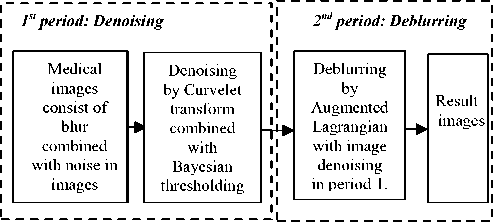
Fig. 2. The processing of proposed method.
Firstly, the inputs are the blur combined with noise in images. We use curvelet transforms for denoising images, the process of curvelets is as follows [11]:
(i) apply the b 1 =b min
à trous algorithm with scales and set
-
( ii) for. j=1, .„, j do
-
+ partition the subband w j with a block size b j and apply the digital ridgelet transform to each block;
-
+ if j modulo 2 = 1 then b j+1 =2b j else b j+1 =b j
The sidelength of the localizing windows is doubled at every other dyadic subband.
Bayesian thresholding is the composition in wavelet transforms, calculates median thresholding and shows result based on the new thresholding. The process of bayesian thresholding can be achieved as follows:
After this period, the input images become denoising images. The result of denoising with curvelet transforms combined with bayesian is good in the types of noise, such as: gaussian, speckle, etc.
Figure 3 shows the denoising image in case of speckle noise using curvelet transforms combined with bayesian thresholdings.

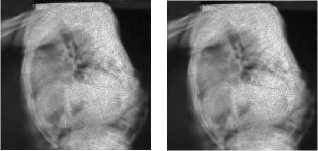
(d) (e)
Fig. 3. A noise image with speckle noise and denoising images by different methods.
-
(a) Original image.
-
(b) Noise image (PSNR = 20.0232 db).
-
(c) Denoising image by DWT (PSNR = 22.7776 db).
-
(d) Denoising image by curvelet transforms (PSNR = 28.8155 db).
-
(e) Denoising image by curvelet transforms combined with bayesian thresholdings (PSNR = 29.0008 db).
From figure 3, the result of the method, curvelet transforms combined with bayesian thresholdings, is the highest. But with Gaussian noise, we use db2 for decomposition and db4 in speckle noise. The results are very satisfactory because Gaussian noise is the summation and speckle noise is the multiplication.
The summation is the noise value will add in each pixel of medical images. So, decomposition needn’t high level. The multiplication is the noise value will accumulate in each pixel of medical images. Removed the multiplication noise must double decomposition value.
Secondly , it is medical image deblurring. The noise in the blur combined with noise images has been removed in the curvelet domain in the above period. The blur in images is not removed more. To remove the blur, we use augmented lagrangian for the output images from the previous period.
In here, we use augmented lagrangian TV/L2 algorithm [13] to remove the blur. The problem that we solve in TV/L2 minimization is:
minimize ^|\Hf - g ||2 +|I f^ (13)
Algorithm of TV/L2, which is used in the proposed method, can be summarized as follows [13]:
-
(i) Input: vector denoting the observed image (g) and convolution matrix (H), regularization parameter Ц , the isotropic total variation Д , в , Д ■
-
(ii) Set parameter with value default for p = 1 ( p is a regularization parameter) for Gaussian blur and p = 2 for motion blur. Then set a = 0.7.
The reason of this choice: Gaussian blur is to strengthen the standard deviation, but motion blur is the movement of objects and sightseeing. Therefore, we set default for regularization parameter of Gaussian blur is 1 and motion blur is 2.
-
(iii) Initialize f 0 = g, u 0 = Df 0 , y = 0, k = 0. (y is the Lagrange multiplier)
-
(iv) Compute the matrices of the first-order forward finite difference operators along the horizontal, vertical and temporal directions.
With not coverage do:
-
1. Solve the f-subproblem is:
f t + 1 = arg min ^ | H - g ||2 - y t ( ut - D f ) + p u ut - D f ||2 f 2 2
by equation:
F [ M HTg + p , Du - Dy ]
A| F [ H ] 2 + p , ( F [ D , ] 2 + F [ D y Л 2 + F [ D t ] 2 )
where F denotes the three-dimensional Fourier Transform operator.
2. Solve the u-subproblem is:
PSNR=20log (
MAX
MSE
)
u k + 1= argmini | u | L - y T ( u - Df k +i ) + ^-Wu - Df k +i||2 u 2
by equation:
ux = max ] Ivxl- — ,0f * sign (vx )
I PrJ
3. Update the Lagrange multiplier:
Ук+1 = yk - Pr(uk+1 - Dfk+1)
where MAX 1 is the maximum pixel value of the image. The proposed method is compared with DWT, CT, and AL method based on the MSE and PSNR values. The smaller the value of MSE is, the better it is. The higher the value of PSNR is, the better it is. We test so many medical images. In here, we show some test cases.
Figure 4 shows the deblurring of blur and noise image which has Gaussian blur combined with Gaussian noise by our proposed method. Figure 5 shows the deblurring of blur and noise image which has Gaussian blur combined with Speckle noise by our proposed method.
4. Update:

(a) (b) (c)
P r
={
YP r , if || u k +1 - Df k +112 ^ 4 u k - Df k 112 p r , otherwise
5. Check convergence: if

(d) (e) (f)
Fig. 4. Denoising and deblurring images in case Gaussian blur is combined with Gaussian noise by different methods.
II f + 1 - f k lLI f lL s tol (20)
then break, else continue.
IV. Experiments and Results
In this section, we apply the procedure described in section 3 and achieved superior performance in our deblurring experiments as demonstrated in this section. For performance evaluation, we compare the results of the proposed method based on curvelet transforms combined with bayesian thresholdings and augmented lagrangian (CTBTAL) with the methods: discrete wavelet transform (DWT), curvelet transforms (CT) and augmented lagrangian (AL). We test the result in medical image datasets, this dataset includes different images of different sizes: 256x256, 512x512. Hard thresholding is applied to the coefficients after decomposition in the curvelet domain. All of the above methods are done on our program and the same images at the similar scale.
The quality of images is improved by comparison with the value of Mean Square Error (MSE) and Peak Signal-to-Noise Ratio (PSNR). The MSE is defined as:
-
(a) Original image.
-
(b) Blur combined with noise in image (PSNR = 25.2391db).
-
(c) Denoised and deblurred image by DWT (PSNR = 28.0690 db).
-
(d) Denoised and deblurred image by AL (PSNR = 26.0581db).
-
(e) Denoised and deblurred image by CT (PSNR = 27.8005db).
-
(f) Denoised and deblurred image by CTBTAL (PSNR = 29.0626 db).
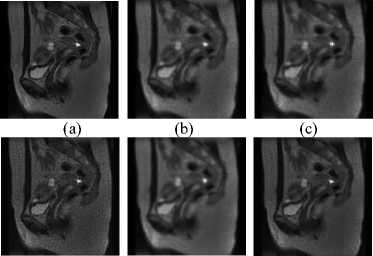
(d) (e) (f)
Fig. 5. Denoising and deblurring images in case Gaussian blur is combined with Speckle noise by different methods.
NN
MSE= 1 (x -y ) 2
NxN i=1 j=1 i,j i,j
where x is the image which has blur and noise, y is the image result and N x N is the size of image. PSNR is used as the measure of quality of reconstruction of image deblurring or denoising, defined as:
-
(a) Original image.
-
(b) Blur combined with noise image (PSNR = 28.9375 db).
-
(c) Denoised and deblurred image by DWT (PSNR = 29.4235 db).
-
(d) Denoised and deblurred image by AL (PSNR = 30.5175 db).
-
(e) Denoised and deblurred image by CT (PSNR = 29.8517 db).
-
(f) Denoised and deblurred image by CTBTAL (PSNR = 31.5662 db).
From figure 4 and figure 5, we see that the result of the proposed method (fig.(f)) is better than the other methods (fig.(c), fig.(d), fig.(e)). Figure 6 show the plot
of PSNR, MSE values of different image deblurring and denoising methods corrupted in case of Gaussian blur combined with Gaussian noise.
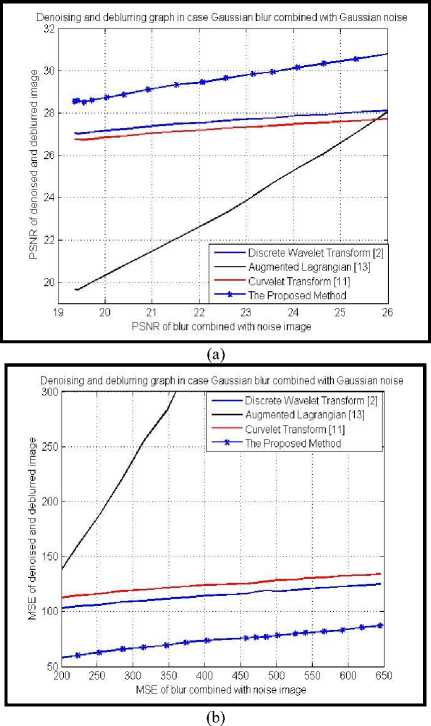
Fig. 6. Plot of PSNR and MSE values of denoised and deblurred images in case of Gaussian blur combined with Gaussian noise using different methods.
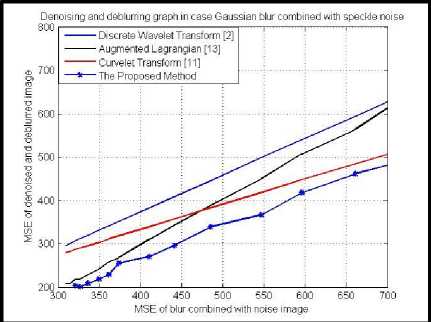
(b)
Fig. 7. Plot of PSNR and MSE values of denoised and deblurred images in case of Gaussian blur combined with speckle noise using different methods.
-
(a) Plot of PSNRvalues of denoised and deblurred images.
-
(b) Plot of MSE values of denoised and deblurred images.
Figure 8 shows the deblurring of blur and noise image in case of motion blur combined with Gaussian noise by our proposed method and the other method. Figure 9 also shows the deblurring of blur and noise image in case of motion blur combined with speckle noise by our proposed method and the other method.

(a)
c)
-
(a) Plot of PSNRvalues of denoised and deblurred images.
-
(b) Plot of MSE values of denoised and deblurred images.
Figure 7 show the plot of PSNR, MSE values of different image denoising and deblurring methods corrupted in case Gaussian blur combined with speckle noise.
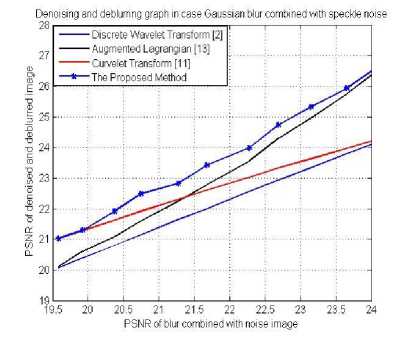
(a)
(d) (e) (f)
Fig. 8. Denoising and deblurring images with motion blur combined with Gaussian noise by different methods.
-
(a) Original image.
-
(b) Blur combined with noise in image (PSNR = 16.9468 db).
-
(c) Denoised and deblurred image by DWT (PSNR = 17.5966 db).
-
(d) Denoised and deblurred image by AL (PSNR = 20.0532 db).
-
(e) Denoised and deblurred image by CT (PSNR = 17.6140 db).
-
(f) Denoised and deblurred image by CTBTAL (PSNR = 22.6687db).
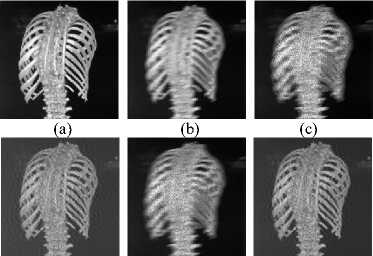
(d) (e) (f)
Fig. 9. Denoising and deblurring images in case of motion blur combined with speckle noise different methods.
-
(a) Original image.
-
(b) Blur combined noise image (PSNR = 17.2759 db).
-
(c) Denoised and deblurred image by DWT (PSNR = 17.4074 db).
-
(d) Denoised and deblurred image by AL (PSNR = 20.1790 db).
-
(e) Denoised and deblurred image by CT (PSNR = 17.6344 db).
-
(f) Denoised and deblurred image by CTBTAL (PSNR = 20.9319 db).
-
From figure 8 and figure 9, we see that the result of the proposed method fig.(f) is better than the other methods (fig.(c), fig.(d) and fig.(e)). Figure 10 show the plot of PSNR, MSE values of different image denoising and deblurring methods corrupted in case of motion blur combined with Gaussian noise.
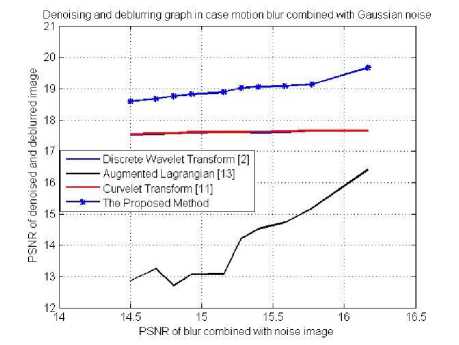
(a)
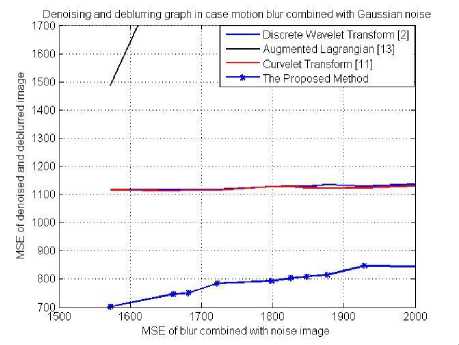
(b)
Fig. 10. Plot of PSNR and MSE values of denoised and deblurred images in case of motion blur combined with Gaussian noise using different methods.
-
(a) Plot of PSNRvalues of denoised and deblurred images.
-
(b) Plot of MSE values of denoised and deblurred images.
Figure 11 show the plot of PSNR and MSE values of different image denoising and deblurring methods corrupted in case of motion blur combined with speckle noise.
With figure 6, figure 7, figure 10 and figure 11, the PSNR values of the proposed method is the highest and the MSE values of the proposed method is the smallest. So, the proposed method performs better than discrete wavelet transform, curvelet transform and augmented lagrangian method. As mentioned in section 3, we improve the denoising processing. Therefore, the proposed method is better than the other method.
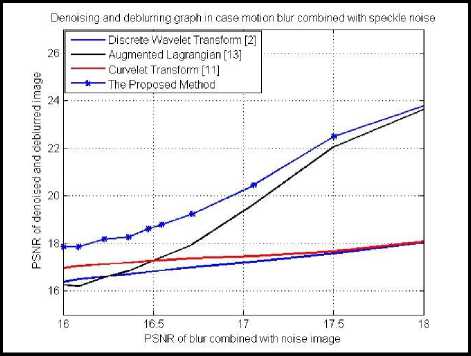
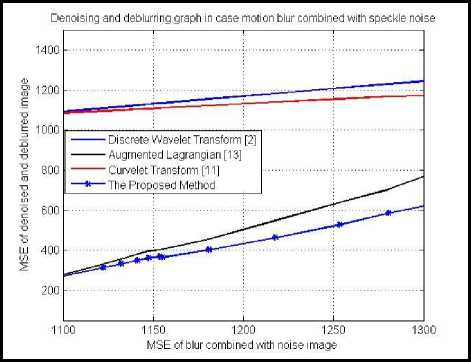
Fig. 11. Plot of PSNR and MSE values of denoised and deblurred images in case of motion blur combined with speckle noise using different methods.
-
(a) Plot of PSNRvalues of denoised and deblurred images.
-
(b) Plot of MSE values of denoised and deblurred images.
-
V. Conclusions
In this paper, we proposed the method for increasing the quality of blur combined with noise image by dividing it into two processes: denoising and deblurring. Firstly, we propose a new method for denoising image based on curvelet transform combined with bayesian thresholding. Then, we apply augmented lagrangian method for deblurring into denoising image. We test the proposed method with Gaussian blur combined with Gaussian noise pair, Gaussian blur combined with speckle noise pair, motion blur combined with Gaussian noise pair, and motion blur combined with speckle noise pair in medical images. From the results of the above section, we conclude that the proposed method works well and better than the other recent methods available in literature such as: discrete wavelet transforms, curvelet transforms and augmented lagrangian. Based on this idea, we think the combination methods can improve the quality of the image which has blurring and noising in case of denoising and deblurring step. Furthermore, we can develop this idea by combining thresholdings or filters in the deblurring or denoising step.
Appendix
Table 1. PSNR values (dB) of different denoised and deblured images with Gaussian blur combined with Gaussian noise.
|
Test Image |
Image Size |
Blur & Noise Image |
DWT[2] |
AL [13] |
CT[11] |
Proposed Method |
|
1 |
256 x 256 |
21.3958 |
25.3283 |
22.0264 |
25.1122 |
26.0232 |
|
2 |
20.6148 |
23.7412 |
21.0870 |
23.8914 |
24.7274 |
|
|
3 |
21.8062 |
25.0981 |
22.5222 |
25.2357 |
26.3515 |
|
|
4 |
19.3783 |
23.5501 |
19.6916 |
23.6754 |
24.9114 |
|
|
5 |
17.8001 |
24.9717 |
17.7717 |
24.9701 |
25.4818 |
|
|
6 |
16.0633 |
20.5249 |
16.3098 |
20.3469 |
21.1879 |
|
|
7 |
15.6079 |
22.3795 |
15.5836 |
22.2922 |
22.9893 |
|
|
8 |
14.9423 |
22.3773 |
14.8368 |
22.4524 |
23.1188 |
|
|
9 |
26.6524 |
31.6191 |
27.6351 |
31.3123 |
33.4234 |
|
|
10 |
24.1366 |
27.6435 |
25.0279 |
27.4658 |
29.4094 |
|
|
11 |
512 x 512 |
24.8521 |
32.9369 |
25.3458 |
32.5904 |
33.8393 |
|
12 |
21.7640 |
24.9861 |
22.7562 |
24.6530 |
26.2621 |
|
|
13 |
20.9965 |
23.5191 |
22.2377 |
23.1775 |
25.1051 |
|
|
14 |
24.2241 |
31.0421 |
24.8162 |
30.5948 |
32.3928 |
|
|
15 |
26.0221 |
31.8145 |
26.8493 |
31.3897 |
33.2971 |
|
|
16 |
20.0243 |
23.8463 |
20.8065 |
23.4914 |
25.4073 |
|
|
17 |
19.7131 |
23.8335 |
20.4062 |
23.4848 |
25.0111 |
|
|
18 |
21.2679 |
27.3645 |
21.8067 |
27.0792 |
29.2639 |
|
|
19 |
22.3948 |
28.6748 |
22.8228 |
28.3454 |
29.5994 |
|
|
20 |
23.9863 |
30.3258 |
24.5808 |
30.0443 |
31.6380 |
Table 2. PSNR values (dB) of different denoised and deblured images with Gaussian blur combined with speckle noise.
|
Test Image |
Image Size |
Blur & Noise Image |
DWT[2] |
AL[13] |
CT [11] |
Proposed Method |
|
1 |
256 x 256 |
23.0920 |
25.5998 |
24.1175 |
25.3611 |
26.4193 |
|
2 |
20.2344 |
20.5992 |
20.5848 |
22.9130 |
23.2919 |
|
|
3 |
21.6390 |
21.7473 |
21.8942 |
21.7346 |
22.6895 |
|
|
4 |
17.5646 |
18.1684 |
17.5961 |
20.6789 |
20.9086 |
|
|
5 |
17.4910 |
21.0917 |
17.3516 |
24.2070 |
24.2351 |
|
|
6 |
18.1855 |
19.419 |
18.7048 |
20.5158 |
21.2482 |
|
|
7 |
22.4617 |
23.0035 |
23.6952 |
24.4640 |
25.9205 |
|
|
8 |
23.2818 |
23.9857 |
24.8751 |
25.1727 |
27.0829 |
|
|
9 |
23.8397 |
23.9484 |
23.9366 |
23.9670 |
24.1572 |
|
|
10 |
25.3260 |
25.7947 |
26.7436 |
27.2852 |
28.7624 |
|
|
11 |
512 x 512 |
25.9560 |
26.7559 |
26.1194 |
28.1989 |
28.2931 |
|
12 |
21.6175 |
23.8826 |
22.4633 |
24.5813 |
25.7629 |
|
|
13 |
21.0589 |
21.3584 |
22.2705 |
21.8535 |
22.8422 |
|
|
14 |
26.8943 |
27.4241 |
27.3779 |
28.2239 |
28.6356 |
|
|
15 |
22.6899 |
23.4968 |
22.8497 |
25.0090 |
25.4673 |
|
|
16 |
24.1621 |
24.2359 |
26.9951 |
24.2192 |
27.0083 |
|
|
17 |
20.7494 |
21.1499 |
21.5973 |
21.9186 |
22.4882 |
|
|
18 |
22.4913 |
23.2765 |
22.9129 |
24.0157 |
24.0499 |
|
|
19 |
24.6980 |
25.1384 |
25.2960 |
26.0356 |
26.0793 |
|
|
20 |
21.4004 |
21.7755 |
22.4325 |
22.3737 |
22.9852 |
Table 3. PSNR values (dB) of different denoised and deblured images with Motion blur combined with Gaussian noise.
|
Test Image |
Image Size |
Blur & Noise Image |
DWT[2] |
AL[13] |
CT [11] |
Proposed Method |
|
1 |
256 x 256 |
23.0159 |
23.9126 |
24.1707 |
23.9211 |
25.4899 |
|
2 |
20.4164 |
21.5119 |
20.7121 |
21.6111 |
23.3620 |
|
|
3 |
18.7250 |
19.9783 |
19.4557 |
20.0889 |
22.9818 |
|
|
4 |
18.1161 |
20.0751 |
17.6501 |
20.1666 |
22.6791 |
|
|
5 |
19.6700 |
23.3954 |
17.5249 |
23.3652 |
24.3956 |
|
|
6 |
16.1661 |
17.6504 |
16.4068 |
17.6499 |
19.6690 |
|
|
7 |
16.3928 |
18.1925 |
15.8901 |
18.1829 |
20.7334 |
|
|
8 |
15.6207 |
18.6812 |
13.6431 |
18.6463 |
20.4013 |
|
|
9 |
17.6315 |
23.0562 |
14.6550 |
23.3315 |
23.8703 |
|
|
10 |
14.9204 |
20.6489 |
11.6314 |
20.8879 |
21.0647 |
|
|
11 |
512 x 512 |
15.0977 |
24.8670 |
11.4825 |
24.5610 |
24.8837 |
|
12 |
11.7964 |
19.4221 |
8.3987 |
19.3432 |
19.8086 |
|
|
13 |
11.3582 |
16.6619 |
8.4165 |
16.7060 |
17.1649 |
|
|
14 |
16.2420 |
22.8994 |
13.1730 |
23.1072 |
23.9144 |
|
|
15 |
14.6604 |
23.3671 |
11.0207 |
23.3920 |
23.6629 |
|
|
16 |
14.7424 |
17.6907 |
13.4450 |
17.6841 |
20.1851 |
|
|
17 |
13.4890 |
17.5244 |
11.2170 |
17.6103 |
19.0756 |
|
|
18 |
17.1167 |
21.5949 |
14.8758 |
21.6374 |
23.8379 |
|
|
19 |
17.1765 |
22.4123 |
14.5668 |
22.5664 |
23.7518 |
|
|
20 |
14.9819 |
22.5403 |
11.6565 |
23.0844 |
23.2075 |
Table 4. PSNR values (dB) of different denoised and deblured images with motion blur combined with speckle noise.
|
Test Image |
Image Size |
Blur & Noise Image |
DWT[2] |
AL[13] |
CT [11] |
Proposed Method |
|
1 |
256 x 256 |
22.4100 |
24.7134 |
21.2940 |
24.6266 |
25.5927 |
|
2 |
19.1920 |
19.5068 |
17.5274 |
21.1395 |
21.3500 |
|
|
3 |
20.4008 |
20.3845 |
20.8618 |
20.4732 |
21.0328 |
|
|
4 |
17.7349 |
18.1884 |
15.5692 |
18.6866 |
20.0897 |
|
|
5 |
18.4259 |
21.3622 |
15.1831 |
22.6422 |
23.9545 |
|
|
6 |
18.5827 |
18.8027 |
20.9717 |
18.9451 |
21.5676 |
|
|
7 |
17.3083 |
18.0587 |
16.5054 |
19.5437 |
19.5775 |
|
|
8 |
16.8926 |
18.2756 |
14.1685 |
20.3064 |
21.0873 |
|
|
9 |
22.4852 |
22.8350 |
22.2780 |
23.9468 |
25.0694 |
|
|
10 |
19.7566 |
20.5159 |
17.2242 |
21.3251 |
22.9169 |
|
|
11 |
512 x 512 |
22.8737 |
23.4814 |
21.2150 |
23.2188 |
24.5355 |
|
12 |
18.1377 |
19.4882 |
18.1496 |
19.8776 |
22.0791 |
|
|
13 |
16.2261 |
16.4821 |
16.6008 |
16.9632 |
17.8333 |
|
|
14 |
19.8124 |
20.3238 |
17.8346 |
18.9662 |
21.2454 |
|
|
15 |
20.9099 |
21.5762 |
18.8455 |
21.0078 |
22.8969 |
|
|
16 |
16.0032 |
16.3796 |
16.2427 |
16.9603 |
17.8581 |
|
|
17 |
15.9016 |
16.2572 |
15.5399 |
16.9014 |
16.9627 |
|
|
18 |
18.0265 |
18.7282 |
16.0603 |
17.1930 |
19.4643 |
|
|
19 |
18.1800 |
18.7034 |
15.7661 |
17.3751 |
19.8848 |
|
|
20 |
19.8650 |
20.2711 |
18.5455 |
19.8791 |
21.0384 |
Acknowledgment
Список литературы Enhancing the Quality of Medical Images Containing Blur Combined with Noise Pair
- G. Strang, Wavelets and dilation equations: A brief introduction, SIAM Review, Vol.31, No.4, 1989.
- Tim Edwards, Discrete Wavelet Transforms: Theory and Implementation, 1992.
- Marcin Kociolek, Andrzej Materka, Michal Strzelecki, Piotr Szczypínski, Discrete Wavelet transform – derived features for digital image texture analysis, Proc. Of International Conference on Signals and Electronic Systems, pp. 163—168, 2001.
- N.T.Binh, Ashish Khare, Image Denoising, Deblurring and Object Tracking, A new Generation wavelet based approach, LAP LAMBERT Academic Publishing, 2013.
- Minh N. Do and Martin Vetterli, The contourlet transform: an efficient directional multiresolution image representation, IEEE Trans. Img. Processing, pp. 2091—2106, 2005.
- Arthur L. da Cunha, Jianping Zhou and Minh N. Do, Nonsubsampled Contourlet Transform: Theory, Design, and Applications, IEEE Trans. Img. Proc, pp.3089—3101, 2005.
- Arthur L. da Cunha, J. Zhou and Minh N. Do, Nonsubsampled Contourlet Transform: Filter design and applications in denoising, 2006.
- E. J. Candes, Ridgelets: Theory and Applications, Stanford University, 1998.
- B. Zhang, J. M. Fadili, and J. L. Starck, Wavelets, ridgelets and curvelets for poisson noise removal, IEEE Transactions on Image Processing, pp.1093—1108, 2008.
- D. L. Donoho and M. R. Duncan, Digital curvelet transform: Strategy, implementation and experiments, Rpoc. SPIE, Vol. 4056, pp. 12—29, 2000.
- Starck J L, Candès E J, Donoho D L, The curvelet transform for image denoising, IEEE Trans. Image Processing, pp. 670—684, 2002.
- Binh NT, Khare A. Multilevel threshold based image denoising in curvelet domain, Journal of computer science and technology, pp. 632—640, 2010.
- Stanley H. chan, Ramsin Khoshabeh, Kristofor B. Gibson, Philip E. Gill and Truong Q. Nguyen, An Augmented Lagrangian Method for Total Variation Video Restoration, IEEE Trans. Image Process, Vol. 20, No. 11, pp 3097—3111, 2011.
- F. Abramovich, T. Sapatinas, B. W. Silverman, Wavelet thresholding via a Bayesian approach, J. R. Statist. Soc. B, pp. 725—749, 1998.
- Sitara K and Remya S, Image deblurring in bayesian framework using template based blur estimation, The International Journal of Multimedia & Its Applications (IJMA), Vol. 4, No. 1, 2012.
- Mingwei Chui, Youquian Feng, Wei Wang, Zhengchao Li, Xiaodong Xu, Image Denoising Method with Adaptive Bayes threshold in Nonsubsampled Contourlet Domain, American Applied Science Research Institute, 2012.
- J. M Lina and M. Mayrand, Complex Daubechies Wavelets, Journal of Applied and Computational Harmonic Analysis, Vol. 2, pp. 219—229, 1995.
- Ashish Khare and Uma Shanker Tiwary, A new method for deblurring and denoising of medical images using complex wavelet transform, IEEE, 2005.
- E. J. Candes, L. Demanet, D.L. Donoho, L. Ying, Fast Discrete Curvelet Transforms, Multiscale Modeling and Simulation, Vol.5, pp. 861—899, 2006.
- A. Khare, U.S Tiwary, Symmetric Daubechies Complex Wavelet Transform and its application to denoising and deblurring, WSEAS Transactions on signal processing, Vol. 2, pp 738—745, 2006.
- Wei Zhang, Fei Yu, Hong-mi Guo, Improved adaptive wavelet threshold for image denoising, Control and Decision Conference, Chinese, pp. 5958-5963, 2009.
- Jennifer Ranjani J., Chithra M. S. Bayesian denoising of ultrasound images using heavy-tailed Levy distribution, IET Image Processing, Volume 9, issue 4, p. 338 – 345, 2015.
- L. Zhang, X. Li, D. Zhang, Image denoising and zooming under the linear minimum mean square-error estimation framework, IET Image Processing, Volume 6, issue 3, p. 273 – 283, 2012.
- Xie Cong-Hua, Chang Jin-Yi, Xu Wen-Bin, Medical image denoising by generalised Gaussian mixture modelling with edge information, IET Image Processing, Volume 8, issue 8, p. 464 – 476, 2014.
- N.T.Binh, V.T.H.Tuyet, P.C.Vinh, Increasing the quality of medical images based on the combination of filters in ridgelet domain, Nature of Computation and Communication, Vol 144, ISSN 1867-8211, Springer, pp 320—331, 2015.
- V.T.H.Tuyet, N.T.Binh, Reducing impurities in medical images based on curvelet domain, Nature of Computation and Communication, Vol 144, ISSN 1867-8211, Springer, pp 306—319, 2015.

